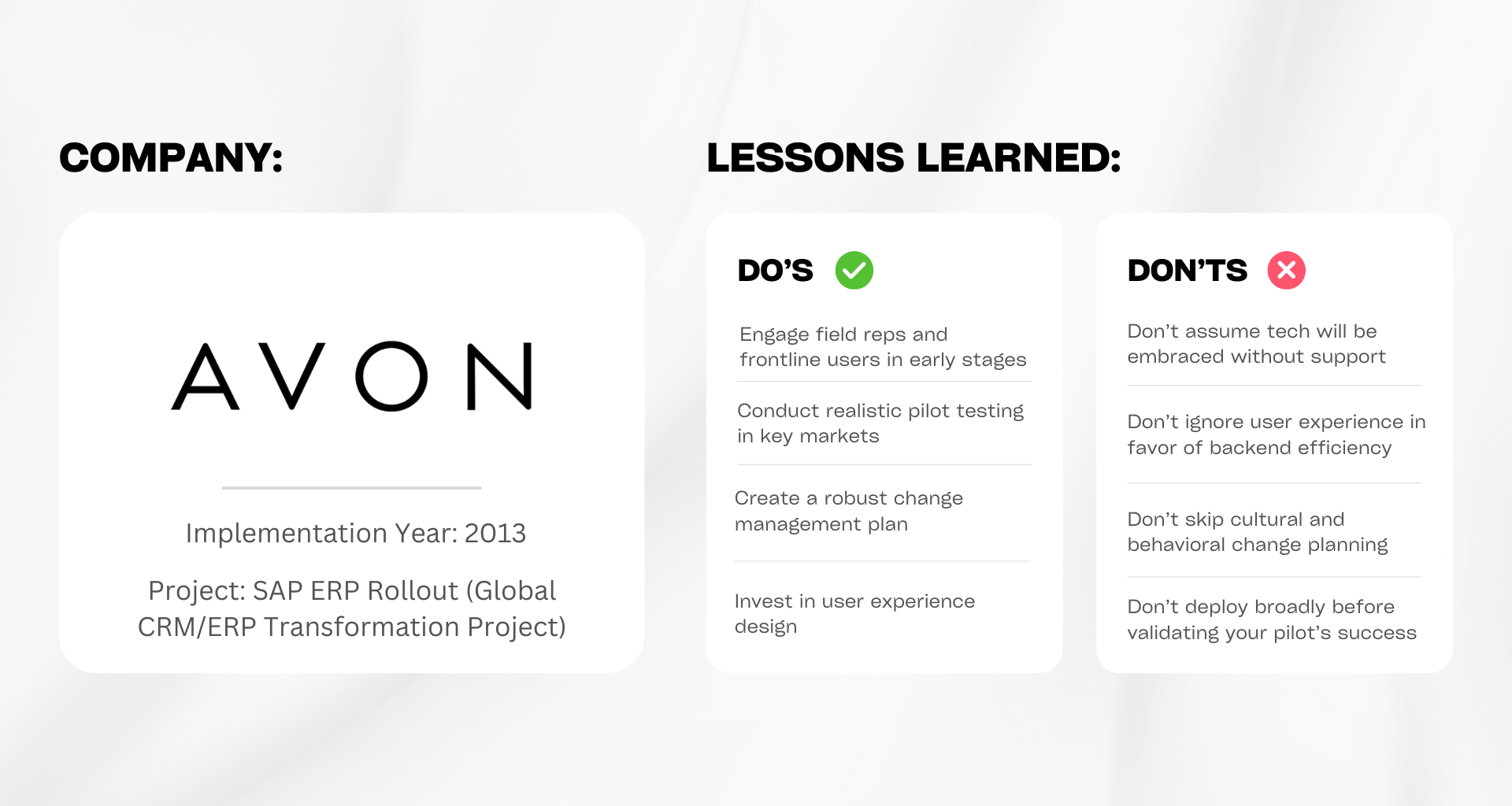Failed ERP Projects Pt 3: What Went Wrong & Lessons Learned
blog/6-use-cases-for-dayforce-integration-studio
2025-05-01
ERP systems promise integration, automation, and efficiency—but when they fail, the consequences are costly.
In this third installment of our ERP failure series, we examine three high-profile projects that failed to deliver: Avon, MillerCoors, and the U.S. Navy.
These stories offer hard-earned lessons for any organization considering an ERP overhaul.
1. Avon’s User Adoption Failure
Overview
In the early 2010s, Avon Products set out to streamline operations across its global markets with a new ERP system built on SAP.
The $125 million initiative was supposed to bring consistency and automation to its sales and supply chain processes.
What Went Wrong
User-Unfriendly Design: The system proved too complicated for Avon’s sales representatives, who relied on a simple and flexible interface to manage their daily tasks.
Poor Change Management: Avon underestimated the cultural and behavioral shift required to adopt the new system.
Inadequate Piloting: The system was rolled out in Canada without sufficient testing or iteration based on real-world use.
Consequences
Mass Attrition: Many Avon representatives in Canada quit rather than work with the new software, directly impacting sales.
Project Cancellation: Avon ultimately pulled the plug on the global rollout after the Canadian pilot failed.
$125 Million Write-Off: The company abandoned the entire project, taking a significant financial loss.
Lessons Learned
Design for the End User: Systems must enhance, not hinder, the user experience—especially when used by a distributed, non-technical workforce.
Pilot with Feedback Loops: Early pilots should be used to gather feedback and make meaningful improvements before broader rollouts.
Plan for Adoption, Not Just Implementation: Technology adoption is behavioral, not just technical—it requires communication, training, and support.
2. MillerCoors’ Over-Integration Gamble
Overview
In 2013, beer giant MillerCoors launched “Project Olympus,” a $100 million ERP initiative to merge the systems of Miller and Coors following their merger.
The new system, built on SAP, aimed to unify supply chains, sales operations, and finance across the company.
What Went Wrong
Over-Centralization: The project tried to standardize every process across diverse business units, leading to friction and inefficiency.
Timeline Pressure: Tight deadlines led to rushed decisions and insufficient testing of key functionalities.
Lack of Cross-Team Alignment: Business units weren’t properly consulted during planning, resulting in misaligned workflows and unmet needs.
Consequences
Operational Disruptions: The new system created bottlenecks in order fulfillment and supply chain operations.
Financial Losses: These disruptions translated into lost sales, increased operational costs, and a wave of negative press.
Leadership Shakeups: Internal reports blamed project mismanagement, contributing to executive turnover.
Lessons Learned
Don’t Sacrifice Agility for Standardization: A unified system still needs to allow for the nuances of different departments or markets.
Give Projects Time to Breathe: Implementation timelines should include buffers for feedback, testing, and iteration.
Stakeholder Buy-In Is Non-Negotiable: Failing to include business unit leaders can cause disconnects between technology and actual needs.
3. U.S. Navy’s $1 Billion Failure
Overview
In the late 1990s and early 2000s, the U.S. Navy initiated an ambitious ERP overhaul to modernize financial and logistics operations across its massive, globally distributed structure.
The goal was to replace aging systems and consolidate dozens of legacy applications.
What Went Wrong
Scope Creep: The project expanded rapidly without clear boundaries, increasing complexity and risk.
Lack of Unified Strategy: Different branches and commands operated in silos, making it nearly impossible to enforce standardized processes.
Vendor Misalignment: Multiple contractors worked on fragmented portions of the system, leading to duplication of work and poor coordination.
Consequences
Over $1 Billion Spent: Despite the investment, the Navy shut down four of its ERP pilot programs due to inefficiency and lack of results.
Audit Failures: The Navy’s financial systems remained so fragmented that the Department of Defense could not pass audits.
Delayed Modernization: The setbacks pushed the Navy’s broader IT modernization plans back by years.
Lessons Learned
Start with a Unified Vision: Clear scope and shared objectives across departments are essential in large-scale transformations.
Centralize Governance: A centralized PMO or oversight body can help maintain consistency across multiple implementations.
Be Realistic About Complexity: The larger the organization, the more time and planning are needed for meaningful transformation.
Conclusion
ERP implementations can be transformative—but only with the right mix of leadership, communication, strategy, and humility.
These failures reveal what happens when even the most well-funded projects overlook the fundamentals.
For organizations considering a transformation, the takeaway is clear: success lies not in the software, but in how it’s executed.













